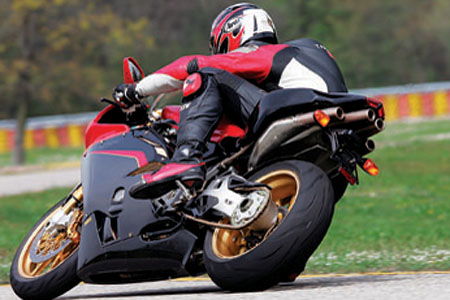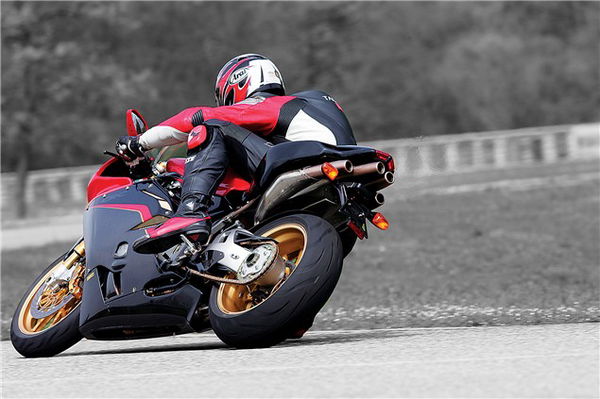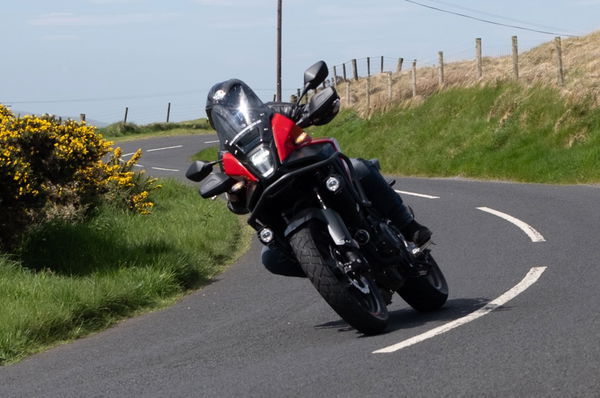Road Test: MV Agusta F4 1000 Tamburini
The latest and most exclusive bike in the F4 series is available - if you've got £30,000 to spare.

 |
The fresh-off-the-production line MV Agusta I'm sitting on is special even by the standards of limited-edition, £30,000 superbikes. The last three digits of the frame number were 012, signifying this was the 12th of the 300 F4 1000 Tamburinis MV is building.
And it so happens that '12' is Claudio Castiglioni's lucky number. Yep, this is the Prez's personal bike. Better not do anything stupid...
There was no doubt about who would end up with the very first off the production line. Massimo Tamburini's exploits have made him a legendary figure, so it's fitting that his name should grace this most glamorous and advanced of F4 derivatives.
Its red-and-black shape is almost identical to that of the original F4, yet somehow the Tamburini machine manages to look every bit as delectable as the original radial-valve four did eight years ago. The jagged pattern of lacquered carbon-fibre weave visible hints this bike is far more special than the F4 1000S with which MV belatedly entered the open-class sports bike market last year.
Tamburini's genius is in his eye for detail, so it's appropriate that this MV has been finished to an even higher level than its predecessors. From the reworked ducts in the fairing, via the red suede seat cover to the beautifully machined, adjustable footrests, the MV is one of those rare bikes that would make even cleaning brake dust and dead flies from it a positive pleasure.
Chassis parts are suitably upmarket, too. Front forks are 50mm diameter upside-down units from Marzocchi, as with the 1000S, but the legs are titanium nitride coated, and 1.2kg lighter. There's a similar saving at the rear, where the Sachs shock, developed from F1 car racing, saves weight by using no gas reservoir.
More weight is shed by the use of aluminium instead of steel for the flanges supporting the 310mm front brake discs. Calipers are one-piece Nissin six-pots, as on the 1000S. Total claimed dry weight is 183kg, a saving of 9kg over the 1000S.
The 998cc engine is every bit as special. Like the similarly limited-edition F4 750 SPR unit, this motor has polished, hand-assembled intakes and high-tech surface discharge spark plugs. Valve sizes are unchanged, but new cams give extra lift.
The most significant innovation is MV's Torque Shift System, or TSS, a mechanical method of altering intake manifold length to suit engine speed. The normal bank of intake trumpets sits below a pivoting aluminium support, which holds four secondary trumpets of slightly smaller diameter. At low revs these are held next to the fixed trumpets, increasing the speed of the mixture entering the engine. At higher revs the Marelli engine management computer triggers a pneumatic system that moves the aluminium support and its secondary trumpets away from the fixed trumpets. This allows the motor to breathe through the wider, fixed intakes for maximum top-end, essentially allowing the engine to give improved low- and midrange , despite being tuned for maximum top-end.
It seems to work. The Tamburini makes a claimed 173bhp at 11,750rpm, 7bhp up on the 1000S's max at the same revs, and you better believe that the Tamburini is every bit as good to ride as those figures suggest. More so, maybe, because no dyno chart can convey the feeling of stretching across the carbon-clad tank to the low clip-ons, and firing up the engine to begin the symphony of sound - through airbox and those four under-seat organ-pipe silencers - that is an ever-present part of the F4 Tamburini experience.
My test took place on the Pirelli test track, and the bike certainly dished out some serious speed. Every lap it was a big buzz to come hammering though a left-right S-bend, then open the tap to send the F4 blasting up the straight with a glorious howl and an occasional flicker of rev-limit light as the revs approached the 12,850rpm maximum through the gears.
The straight was gobbled up in a few short seconds of eyeball-rotating violence, then it was time to haul on the super-powerful anchors, flick down through the box with the MV's EBS electronic back-torque limiter preventing rear-wheel lock-up, and pitch the bike into a tricky, decreasing-radius right-hander.
That tight turn highlighted the motor's flexibility, because the bike kicked out of it with a surge of smooth power. The TSS system was no doubt doing its stuff, though it was sophisticated enough that I wasn't aware of it operating.
Flickability through the slow sections was impressive. Its only hint of instability was a definite but not worrying twitch of the bars, despite the transverse steering damper, as it powered onto the straight. Even that could probably have been dialled out given time to fiddle with the set-up options and countless suspension permutations. Although there wasn't enough time for full exploration of the Sachs shock's potential for fine-tuning, it had the taut yet compliant feel of a seriously high quality unit.
The bike seems as well put together as it is beautiful, and its light weight and flexible power would be useful even if you weren't using anywhere near all the performance.
But ultimate performance and exclusivity never come cheap. In pure performance terms it's impossible to justify spending twice the price of an F4 1000S on this bike, despite its extra power and crisper chassis.
But if money's no object and you just have to have the most powerful, exotic, stylish and rapid superbike that MV Agusta and arguably any other manufacturer has ever built, then you'd better hope that one of those 300 units - 19 are earmarked for the UK - is still available. The F4 Tamburini fully lives up to its legendary name.
SPECS
TYPE - Supersports
PRODUCTION DATE - 2005
PRICE NEW - £30,000
ENGINE CAPACITY - 998cc
POWER - 173bhp@11,750rpm
TORQUE - 84lb.ft@9200rpm
WEIGHT - 183kg
SEAT HEIGHT - 810mm
FUEL CAPACITY - 21L
TOP SPEED - 185mph
0-60 - n/a
TANK RANGE - n/a

The fresh-off-the-production line MV Agusta I'm sitting on is special even by the standards of limited-edition, £30,000 superbikes. The last three digits of the frame number were 012, signifying this was the 12th of the 300 F4 1000 Tamburinis MV is building.
And it so happens that '12' is Claudio Castiglioni's lucky number. Yep, this is the Prez's personal bike. Better not do anything stupid...
There was no doubt about who would end up with the very first off the production line. Massimo Tamburini's exploits have made him a legendary figure, so it's fitting that his name should grace this most glamorous and advanced of F4 derivatives.
Its red-and-black shape is almost identical to that of the original F4, yet somehow the Tamburini machine manages to look every bit as delectable as the original radial-valve four did eight years ago. The jagged pattern of lacquered carbon-fibre weave visible hints this bike is far more special than the F4 1000S with which MV belatedly entered the open-class sports bike market last year.
Tamburini's genius is in his eye for detail, so it's appropriate that this MV has been finished to an even higher level than its predecessors. From the reworked ducts in the fairing, via the red suede seat cover to the beautifully machined, adjustable footrests, the MV is one of those rare bikes that would make even cleaning brake dust and dead flies from it a positive pleasure.











